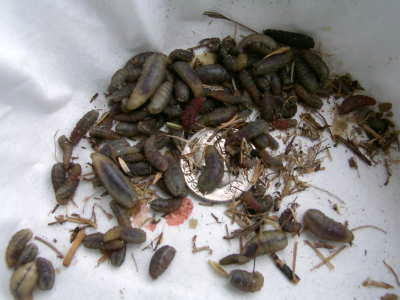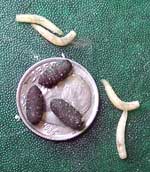Quick Tips: Blow flies suck blood from bird nestlings. They can cause anemia, but unless the infestation is quite severe, or they are stressed (e.g., underfed, wet nest, etc.), they typically don’t kill nestlings (although they may cause delayed fledging.) If a nest is infested, consider a nest change, prevent wet nests, and clean out the box after each fledging.
Blow flies (Protocalliphora sp. and Trypocalliphora sp.) (written as two words) are flies that look kind of like houseflies. Bird blow flies lay eggs in birds nests, on or next to nestlings of birds including bluebirds, swallows, chickadees, wrens, warblers, flycatchers and raptors, shortly before or after the nestlings hatch. Multiple infestations can occur in nestlings that spend several weeks in the nest. Developing blow fly larvae tend to stay very close to the nestlings because it is warmer underneath the birds and this accelerates larval development. The gray maggots use a mouth hook to cut through the nestling’s skin in order to suck their blood, ala vampires of myth.
More than 100 blow flies were found in an Eastern Bluebird nest on my Chimalis Trail in Woodstock, CT on 7/27/04. Note the various sizes of larvae relative to a dime. This is because the blow fly eggs may have been laid at different times, or some are engorged with blood and others are not. The nestbox held five 11-12 day old nestlings which appeared to be quite healthy.  I replaced the nest.
I replaced the nest.
Almost all bluebird and Tree Swallow nests on my trail get blow fly larvae in them. One study in found 94.5% of Western Bluebird nests in thin forests had blow flies. (Germaine and Germaine 2002). Another in NY found about 70% of 51 Eastern Bluebird nests had blow flies of the species P. sialia (a bluebottle fly.) (Roby et al. 1992). They had an average of 95 blow flies per nest (the maximum was 471.) Other researchers reported as many as 970 larvae in a single nest (Sabrosky & Bennet, 1956.)
Dr. Terry Whitworth, a researcher who has been studying blow flies since the 1970’s, indicates that in most areas, around 5-10% of infested nests are likely to have sufficient larval populations to make nestlings sick. He estimates that when larval populations exceed about 10 actively feeding 3rd instar larvae per nestling, nestlings may become anemic and more susceptible to starvation, hypothermia and other parasites like mites, fleas, and lice. It may also take them longer to fledge.
IDENTIFICATION
 Check Blow Fly Information and Research to learn about this parasite. This site has pictures of blow fly larvae at various stages of development. More pictures here: Ectoparasites.
Check Blow Fly Information and Research to learn about this parasite. This site has pictures of blow fly larvae at various stages of development. More pictures here: Ectoparasites.
Blow fly larvae can be pearly white, translucent gray, or gray with a reddish tinge. They look kind of like a grain of rice or a maggot (only stumpier – shaped more like a football or a rat turd). Once they have fed, they look darker and you maybe able to see blood inside their bodies. Blow Fly larvae get up to 12 mm long. After about 5-15 days, they turn into pupa. The pupal cases (which are left behind after the larva turn into flies) are purplish-brown in color, oblong in shape, and are about 10 mm long. The pupa crawl up through nesting material to feed on nestlings. (Videos show they can climb across glass or Plexiglas too.) The larvae may leave damp frass behind. After 7-10 days (depending on the species of blow fly), the pupa morph into adults. The pupal cases are left behind. Adult female blow flies resemble shiny-green house flies.
Blow Fly larvae seem more common when outdoor temperatures are warm – 70 degrees and above. In colder weather, they may become somewhat dormant, and cannot move up to feed on nestlings. On my trail, they are more common in boxes near wetlands.
Blow flies may attach to a nestlings’ feet, legs, toes, abdomen, beak, ear cavities, and the bases of growing wing and tail feathers, and under the chin. You may see tiny red marks or scabs on a nestling’s abdomen. Sometimes blow fly try to attack adult birds, but the adults pick them off.
Sometimes hundreds of small, white maggots are found feeding on the remains of dead nestlings. These are not blow fly larvae. They are probably the larvae of non-parasitic, carrion-feeding flies, the beneficial cleanup crew of the insect world. They had nothing to do with causing the nestlings’ deaths. You should remove any dead nestlings found in a nestbox.
Fecal sacs produced by parasitized nestlings break open easily when parents try to remove them from the nest. Nestlings legs may be shorter, but parasitism had no consistent effect on hemocrit, growth rate, wing length or mass. (Demas 1989.)
CONTROL OPTIONS
There is no way that I know of to prevent blow flies from laying eggs in nests.
- The earlier blow fly larvae are found and removed, the better for hatchlings and nestlings. Sometimes by gently rubbing through the ‘dust‘ on the box floor under the nest, blow fly larvae can be felt before they can be seen (they really blend in with the dust).
- A significant infestation of blow fly larvae (>10 per nestling) may require nest replacement. (Note: Technically, this is illegal. But then, technically, other aspects of monitoring may also be considered illegal.) This may need to be repeated for the same nesting as new blow fly eggs are laid and hatch in as little as 36-48 hours. Moving the baby birds from the infested nest to the replacement nest can be dangerous to the baby birds’ soft bones, so do not “roll” them. See info on how to do a nest change. A good time to do this is when the babies are about 7-10 days old.
- Steve Gilbertson has recommended making a new nest several days after nestlings hatch. (He also recommends placing the nest in a paper coffee filter that blo flies can not eat through. However, since adults lay eggs near the nestlings, this probably will not help.)
- Make sure the interior of your nestbox is dry – wet nests seem more likely to have blow flies. If you do have a wet nest, figure out why and fix it – read more.
- Connie Toop’s book Bluebirds Forever indicates that Dick Peterson found that Peterson style boxes had fewer blow flies (1/10th the number of fly larvae found in boxes with larger floors). Peterson boxes do have a slanted floor which means the blow fly concentrate towards the front door, which makes it easier to remove them.
- Cut small drainage holes in the bottom corners of the nestbox floor (e.g., a steep sided 1.5″ triangle), which may help keep the nest dry, and perhaps larvae will fall out of the box. These drainage holes tend to get clogged with nesting material, so clean them out periodically.
- A hardware cloth screen below the nest, elevated from the nestbox floor, can make it easier for monitors to remove blow fly larvae. Use a 3/8 square mesh hardware cloth (1/2″ hardware cloth allows chickadee eggs and too much nesting material to fall through it, and a nestling could get caught in it! 3/4 inches is too tight, per SIALIA Vol.4 No.2, Spring 1982, p.49-51, Ira Campbell) in a squared “U” shape or slid into slots in the insides of the box to keep the nest about a half-inch to one inch off the box floor. Debate about these screens includes concerns that by the time the larvae are heavy enough to fall out of the nest and through the screen, they’ve done most of their damage to the baby birds. However, the screens do make it easier to sweep out larvae and will help keep the nest dry (blow flies are often found in damp nests). You may want to put the screen in AFTER the nest is built to prevent pushing material down through it during nest construction. (If you put it in before the nest is built, the bluebirds are likely to stuff the nesting material down through it.) Or you can put a block of wood/piece of masonite under the screen until after the eggs hatch. This may also help keep a nest dry. However, since larvae don’t leave the nestlings until they have completed feeding and are ready to pupate (which is why you tend to see mature larvae and pupae at the bottom of the nest), this may not do much good.
- Low-level (0.03 – 0.1%) pyrethrin pesticide can be used under the nest. However, this is still a toxin and may be considered a last resort.
- Put crumpled bay leaves in the bottom of the box (I have no idea whether this works.)
- Try putting dried lavender (Augustifolia True English or True Munstead) underneath the nest – it may act as a repellent.
- Jewel Wasps are a tiny, iridescent gnat-like insect that parasitize the parasitic blow fly pupa. There are four species – Nasonia vitripennis is a generalist that uses a variety of hosts, including blow fly, and Nasonia giraulti prefers Protocalliphora sp. These body snatchers inject a blow fly pupae with venom and then lay 20-40 of their eggs in it. The Jewel Wasp eggs hatch in a couple of days and eat the blow fly larvae, emerging about 2 weeks later. To help with Jewel Wasp reproduction, either throw old nests in the woods (not near a box, as they could attract predators) or place old nests that show signs of blow fly infestation in buckets or barrels left in a carport or barn (out of the sun and protected from rain) with the top covered with 1/8″ screen (window screen). This allows Jewel Wasps to escape, but traps the blow flies.
- If you find blow fly larvae attached to the nestlings, you might feel tempted to pull them off and squash them. Unfortunately, this is totally ineffective since only about 1-2% of the larvae present in each nest are feeding at any given time during daylight hours.
- Some folks feel it is best to let nature take it’s course, and ensure that only the strongest nestlings survive to breed and improve the population overall, and leave blow flies alone.
References and More Information:
- Terry Whitworth’s blow fly site
- Summary of blow fly research (The Bluebird Box)
- Newsletter of the Michigan Entomological Society, Vol.40, No. 2&3, October 1995,
- Predator and Problem ID, Sialis.org
- How to do a nest change, Sialis.org
- How to clean out a nestbox, Sialis.org
- The genetic basis of interspecies host preference differences in the model parasitoid Nasonia, Desjardins et al, Heredity (Edinb). 2010 Mar;104(3):270-7. doi: 10.1038/hdy.2009.145. Epub 2010 Jan 20, http://www.ncbi.nlm.nih.gov/pubmed/20087393
– Steve Grooms and Dick Peterson, Bluebirds, 1991
